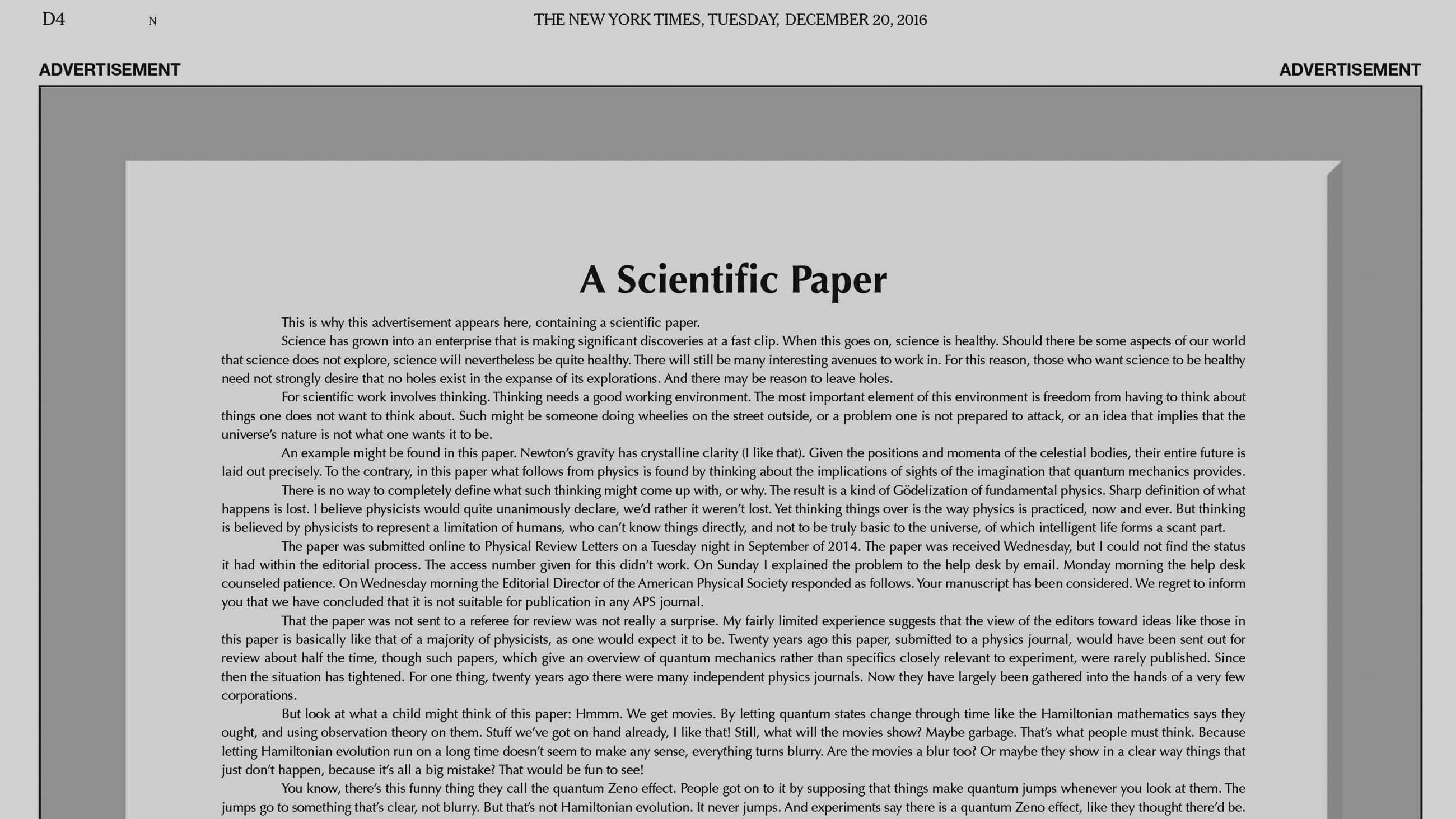Science Paper Rejected? Buy Space in The NYT.
An unusual essay filled two full pages of the print edition of The New York Times’ science section last week.
“A Scientific Paper” crowed the piece’s headline in the December 20, 2016, Science Times section. A long, dense and puzzling essay titled “Will and Physics,” by one Donald McCartor, followed a 15-paragraph introduction. That introduction noted that the manuscript had been rejected in 2014 for publication in any American Physical Society journal.
Twin “ADVERTISEMENT” slugs topped the piece on pages D4 and D5. A gray border framed the copy, and the font throughout differed from the Times’ classic Cheltenham used in the print edition. Many online and print news publications rely on similar cues to demarcate advertising copy from news.
The 80-year-old McCartor, unaffiliated with any research institution, says he simply wanted to share his ideas about quantum mechanics and free will — but the ad left many readers (and media watchers) scratching their heads.
McCartor’s paper has never been edited or peer-reviewed professionally, so I consulted philosopher Dan Lloyd at Trinity College for some insights into the essay’s ideas. [Disclosure: he’s my uncle.] McCartor’s points basically echo familiar, more comprehensive attempts by Stuart Hameroff and Roger Penrose, Lloyd says, to apply quantum indeterminacy to the question of whether we all have free will — that is, whether or not our thoughts and actions are determined in advance, like other physical processes.

Donald McCartor couldn’t get his scientific ideas published in a journal. So he published them in an advertisement in The New York Times.
Philosophers and neuroscientists have, in fact, mostly thought this issue through. “Many of us are ‘compatibilists’ about free will,” Lloyd says, noting among them David Hume and Daniel Dennett. “Wills are free when we act for reasons within us, rather than via compulsions from without.”
The more prosaic question, of course, is what the advertisement was doing there in the first place. The unusual, double-truck display arrives during a troublesome era for media, when hundreds of news and academic publishers with gravely wounded business models are seizing and even closing. And while the use of advertisement space to publish journal-style papers is unlikely to become a steady revenue generator for The Times, the ad brings to mind some newer practices in the publishing world.
Various academic journals now operate on a pay-to-play basis rather than relying on dwindling advertising and subscription dollars. Scholars, their grants, or their employers pay a fee to a journal once their research paper is accepted for publication. But the most highly regarded of these publishers primarily publish peer-reviewed and heavily edited papers. And the papers are laid out to editorial standards, not within advertising boxes.
McCartor says he paid $44,000 for the two-page spread in Science Times, and while the paper draws the line at tobacco ads, “topless” ads, and medical quackery, anyone with money is free to publish in The Times’ advertising space, according to Steph Jespersen, the director of advertising acceptability at the newspaper. Ads can include research papers, opinion essays, or just about any other message. Jespersen makes suitability calls daily, without knowledge of the cost of each ad.
The Times has many advertising topic categories, each with its own rate structure. This ad fell within the “advocacy” category, Jespersen says. “As long as the ad is presented in good taste and is not hate speech, and doesn’t violate anyone’s civil rights,” he says, “then we’re okay with it.”
Various fonts and graphic elements — the “ADVERTISEMENT” rubric, for example, or the borders — can be used to make sure the copy looks like an ad, not news, Jespersen adds.
Advocacy and opinion ads overall contribute significant revenue to the newspaper, Jespersen says. Topics might include the president-elect, international politics or mass shootings. But the Times has published only a few other scientific papers or opinions in its ad space, he says.
Advertisements that meet The Times’ standards may be labeled as a monologue, a notice, or a message.
“Whatever they want to call them, they can call them that,” Jespersen says. “As long as they don’t call them news.”











Comments are automatically closed one year after article publication. Archived comments are below.
This is a strange ad to say the least. You’re right, I haven’t seen many ads like that in the NYT. Thanks for sharing, great read
Eliot Jacobson
As an avid reader of Scientific American, I am quite used to these sorts of pseudo-scientific self-promoting absurdities. Just this month, for example, SciAm had a page with “Advertisement Feature” prominently printed at its top. I cannot imagine how embarrassing it would be to see ones “research” published with the text “Advertisement” printed above it. If this was your work, would you show it to your children?
I am disturbed by the dismissiveness of the paragraph above reading: “Philosophers and neuroscientists have, in fact, mostly thought this issue through. ‘Many of us are “compatibilists” about free will,’ Lloyd says, noting among them David Hume and Daniel Dennett. ‘Wills are free when we act for reasons within us, rather than via compulsions from without.'”
Ignoring the issue of identity, and what distinguishes “reasons within us” from “compulsions from without,” every month, I read about new developments in neuroscience that provide new grist for reconsideration of the issue of free will and its legal consequent, responsibility. (As an undergraduate major in Philosophy-Psychology and a retired attorney, now writing spec fic, this is a particular interest of mine.)
I realize this article was not about the content of Mr. McCartor’s “advertisement,” but its placement. However, this article’s contemptuous treatment of that content demonstrates the very barriers to publication of independent theses that David Anderson references in his comment.
Finally, unless one is good with social media promotion techniques, self-publication is not an effective alternative for disseminating one’s scientific or ethical theories. Though given the amount Mr. McCartor spent on his Science Times ad, he could have paid a publicist instead.
This is an old tradition. When I was growing up in the 1960s, the New York Times would have one or two of these self published “scientific” screeds every year. That was even before they had a separate science section. There was also Vantage Press’s weekly vanity press ad which advertised a number of self published books. Some of them were fiction, some were memoirs and some were scientific tracts.
I remember one such ad, I think a full page at the back of a section, had a proof that god existed based on coincidences in the Manhattan phone book. That one was famous and often cited as proof that humans are goofy in case someone hadn’t figured that out already. A number involved quantum mechanics, various biological theories and so on. At least one was pushing DMSO. I’m surprised people are still publishing these what with so many self publishing options like Amazon and arxiv.
Well, I wrote a book entitled “Hidden Data: The Blind Eye of Science”. Actually sent a copy to Ivan Oransky who did not find it exciting enough to mention in the Retraction Watch — guess probabilities of less than ten to the minus 200 are just not all that significant. So I bought an ad in the Sunday book review section of the Times for about $5000. Made essentially no impact on my Google reader score on my website (www.helenezhill.com). You can buy my book at a bargain basement price on Amazon or download on Kindle for even less. My conclusion: nobody really cares. I sent a copy to our Chancellor (Rutgers Biomedical and Health Sciences) no response, ORI, no response and so on. Have by now sent ( for free to recipients) about 60 copies with maybe 10 thank yous. Who cares? Scientific fraud is just a curiosity. Other types of white collar crime put you in jail but cheat in science and get a slap on the wrist and a year or two on the sidelines.
It would have been much cheaper — and probably much faster — for the author to publish his article in one of the journals from the Switzerland-based publisher Frontiers, which specializes in publishing papers rejected from legitimate journals.
I agree to some extent, some of these predator publishers will “publish” your work for 500 dollars. But then again, they essentially just hang ur paper on a virtual bulletin board that nobody reads. If we look at it from the publicity point of view, the author definitely got 100 times more attention from advertising it on the NYT which was money well spent.
How different this one is from predatory journals. The only legitimate difference is advertisement!
On the other hand, the cronyism in scientific fields is so bad now that there are probably more meritorious papers that go unpublished than find their way into print. The fact is that many, if not most, great discoveries were ignored or rejected by those protecting established knowledge throughout the history of science. So I wouldn’t be too quick to judge a paper just because it has not been peer reviewed by journal editors and their friends.
It was VERY obvious, even to someone just casually flipping through the science section, that this was an ad and not an article. And two minutes’ worth of reading was more than enough to underscore that fact.
Thanks for tracking down the ad’s origins, Robin. I’m still kind of curious about who this guy is, though, and about why he wrote that he’d been turned down by AIP journals if in fact his article has never been peer reviewed. Did he refuse an interview with you?
I corresponded with Donald McCartor a few times via email. He did not want to speak on the phone for a reason that seemed fair. He says he has not worked in academia nor has he had a career. My understanding of the ad introduction is that the editorial director of APS turned down the paper for all its journals without sending it out for review. I confirmed with McCartor that the paper has never been reviewed.
A logical and predictable consequence of advertorialism: baloney dressed up as a well-researched and edited NYT science article presented as if it is a legitimate story. The fact that a reputable scientific journal would not publish this vanity “research” is reason enough for the Times, even if strapped for cash, to print the words “paid advertisement” in LARGE, bold typeface above this ad and print it in a typeface not its own. Bad call, editors, and a great disservice to your readers. I am very disturbed by this decision. It is not only creepy, it sets a new low in fake news.
It’s very obviously NOT published as news. It’s clearly marked as ADVERTISEMENT; the typesetting is completely different from every news article published by The Times. It’s labeled “A Scientific Paper.” Ms. Donovan, if you missed these very clear signs that the piece is published as an ad rather than as news, I suggest the issue is with your (lack of) perception, not with The Times’ decision.